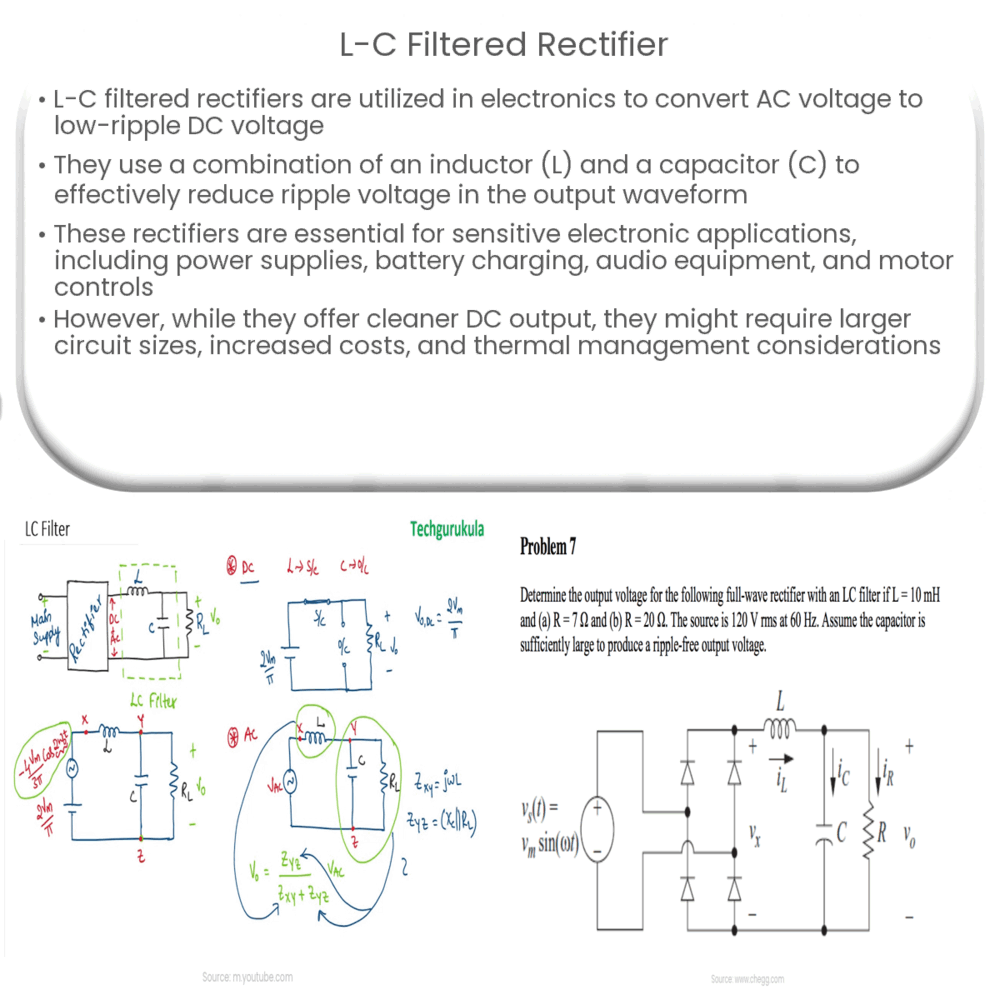L-C filtered rectifiers convert AC to stable, low-ripple DC voltage, ideal for sensitive electronics, battery charging, and audio equipment.

L-C Filtered Rectifier: An Overview
Introduction
A rectifier is an essential component in electronic circuits, responsible for converting alternating current (AC) into direct current (DC). There are various types of rectifiers, and among them, L-C filtered rectifiers are known for their effectiveness in reducing ripple voltage and improving the output waveform. This article will delve into the principles and applications of L-C filtered rectifiers.
Basic Principles of Rectification
Rectification is the process of converting an AC voltage into a pulsating DC voltage. A simple diode rectifier can perform this task, but it results in a high amount of ripple voltage, which is the residual AC component present in the output waveform. This ripple voltage can cause undesirable effects on the load and interfere with the proper functioning of electronic devices. To minimize ripple voltage and obtain a smooth, near-constant DC output, filter circuits are employed in conjunction with rectifiers.
L-C Filtered Rectifiers
An L-C filtered rectifier is a type of rectifier that uses a combination of an inductor (L) and a capacitor (C) to filter the output waveform, reducing the ripple voltage. The inductor and capacitor are connected in series with the diode rectifier, forming an L-C low-pass filter that allows only low-frequency components (DC) to pass through while attenuating the high-frequency components (ripple voltage).
The effectiveness of an L-C filter depends on the inductor and capacitor values. A larger inductor and capacitor will result in better filtering performance but may increase the circuit size and cost. Therefore, an optimal balance between filtering performance and component size should be considered when designing an L-C filtered rectifier.
Applications of L-C Filtered Rectifiers
L-C filtered rectifiers are commonly used in various applications where a stable and low-ripple DC voltage is required. Some of these applications include:
- Power supplies for sensitive electronic devices such as computers, communication systems, and instrumentation
- Battery charging circuits, where a constant and stable DC voltage is needed to charge the battery efficiently
- Audio equipment, where a clean DC voltage is essential to minimize noise and distortion in the output signal
- Motor control circuits, where a smooth and stable DC voltage ensures efficient and precise motor operation
In summary, an L-C filtered rectifier is a versatile and effective solution for converting AC voltage to a stable, low-ripple DC voltage in various applications. By employing an L-C filter in conjunction with a diode rectifier, the output waveform is significantly improved, ensuring the proper functioning of electronic devices and systems.
Design Considerations for L-C Filtered Rectifiers
When designing an L-C filtered rectifier, several factors must be taken into account to optimize performance, efficiency, and cost. Some of these factors include:
- Inductor and Capacitor Selection: Choosing the right inductor and capacitor values is crucial for achieving the desired filtering performance. A larger inductor and capacitor value will provide better filtering but may increase the circuit size, weight, and cost. Designers should consider these trade-offs and select components that offer the best balance between performance and practicality.
- Load Requirements: The load characteristics, such as the required output voltage and current, must be considered when designing an L-C filtered rectifier. The filter components should be able to handle the load current without exceeding their ratings, and the output voltage should remain within acceptable limits under all load conditions.
- Thermal Management: L-C filtered rectifiers may generate heat due to power dissipation in the diodes and filter components. Adequate thermal management measures, such as heatsinks or cooling fans, should be incorporated into the design to ensure reliable operation and prevent overheating.
- Efficiency: Minimizing power losses in the rectifier and filter components is essential for maximizing efficiency. Designers should select components with low power losses and consider using more advanced rectifier topologies, such as synchronous rectification, to improve efficiency further.
Advantages and Disadvantages of L-C Filtered Rectifiers
Like any other circuit topology, L-C filtered rectifiers have their pros and cons. Some of the main advantages and disadvantages include:
Advantages
- Significant reduction of ripple voltage, leading to a cleaner and more stable DC output
- Simple and relatively easy to design and implement
- Wide range of applications, including sensitive electronic devices and systems
Disadvantages
- Potentially larger circuit size and cost due to the inductor and capacitor components
- Increased power losses compared to other advanced rectifier topologies, leading to lower efficiency
- Possible need for additional thermal management measures
Conclusion
L-C filtered rectifiers are an important tool in electronics, providing a stable and low-ripple DC voltage for a wide range of applications. While they have some disadvantages, such as increased circuit size and power losses, their effectiveness in reducing ripple voltage makes them a popular choice in many situations. By carefully considering the design factors and weighing the advantages and disadvantages, engineers can implement L-C filtered rectifiers to deliver clean and stable DC power to their electronic devices and systems.



